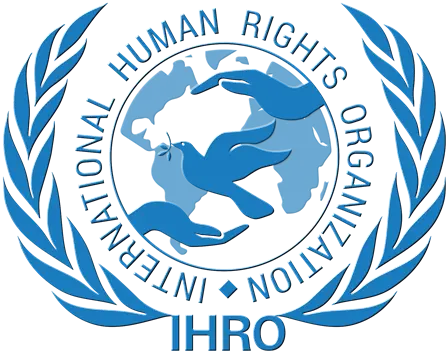Children in the Mines: The Childish Face of Labor Exploitation
Here you will find a space dedicated to the exploration and in-depth analysis of human rights at a global level. In our main article, "Children in Mines: The Childish Face of Labor Exploitation," we unravel the problem of child labor exploitation in mines and its impact on society. We invite you to delve into this important topic and discover how together we can work for a more just world.
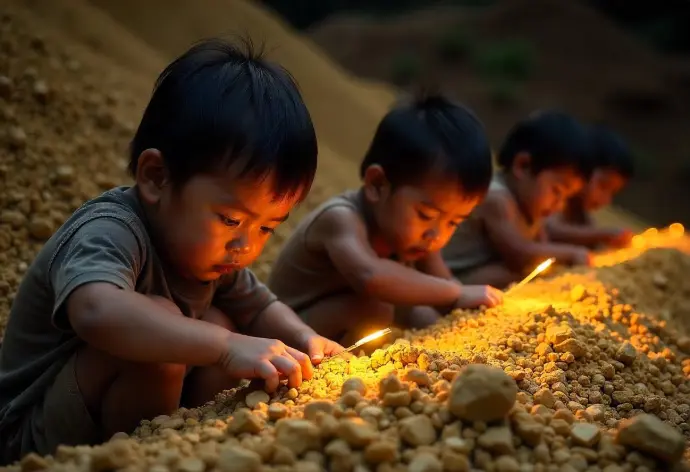

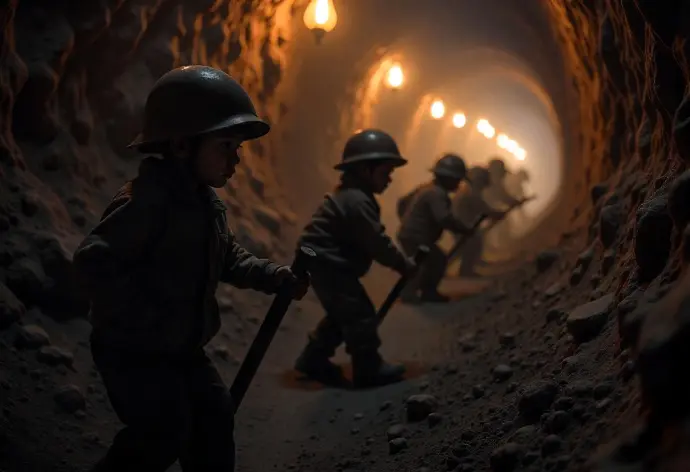
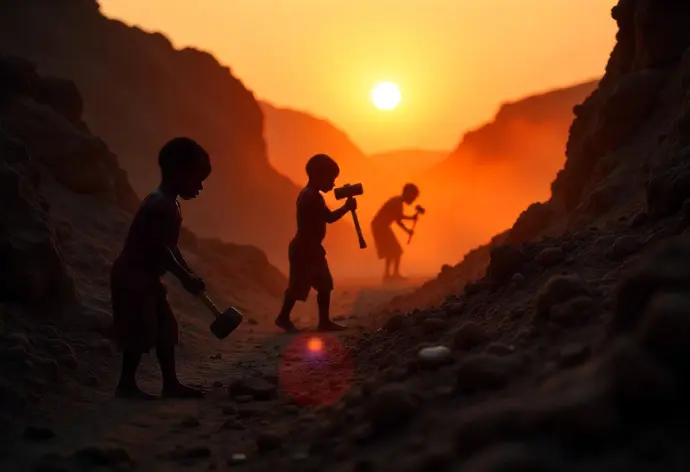
Introduction
Child labor exploitation in the mining industry is a problem that affects children worldwide, depriving them of their childhood, education, and opportunities for a better future. Children working in mines are often exposed to dangerous conditions that are detrimental to their health and well-being. This practice negatively impacts their physical, mental, and emotional development, leaving scars that last throughout their lives. Child labor exploitation undermines children's fundamental rights and perpetuates a cycle of poverty and inequality.
The lack of effective regulations and inadequate supervision in mines, along with the demand for cheap labor, contribute to the persistence of this problem. Children are often used to perform dangerous and exhausting work, such as manual mineral extraction, loading and unloading heavy materials, and exposure to toxic chemicals. This exploitation not only endangers children's lives and health, but also disrupts their education and overall development.
Understanding the devastating impact of child labor exploitation in the mining industry is critical to taking effective measures to protect the rights and well-being of children involved in this activity.
The statistics related to child labor exploitation in the mining industry are deeply troubling. According to the International Labor Organization (ILO), an estimated 1 million children work in mines worldwide, exposing them to extremely dangerous and harmful conditions. These children work long hours in hostile environments, facing risks to their health and safety daily.
Furthermore, many of these children lack access to education or adequate healthcare services. The lack of educational opportunities and exposure to hazardous work environments perpetuate a cycle of poverty and limit these children's chances of a prosperous future.
Alarming statistics underscore the urgent need to address and combat child labor exploitation in the mining industry globally, implementing effective measures to protect children and ensure a safe and nurturing environment for their development.
The consequences of child labor exploitation in the mining industry have a devastating short- and long-term impact on the lives of affected children. Physically, many of these children suffer serious injuries, respiratory illnesses, and other health problems resulting from their exposure to contaminated and hazardous mining environments.
Emotionally and psychologically, child labor exploitation can leave lasting consequences, including post-traumatic stress disorder, anxiety, depression, and a sense of hopelessness about the future. The lack of educational opportunities and working in deplorable conditions also limit their prospects for personal and professional growth.
In the long term, child labor exploitation in the mining industry perpetuates an intergenerational cycle of poverty, as children deprived of an adequate education and exposed to harmful working conditions are less likely to break the cycle of poverty in their adult lives. This impact extends to their future families and communities, perpetuating inequality and suffering.
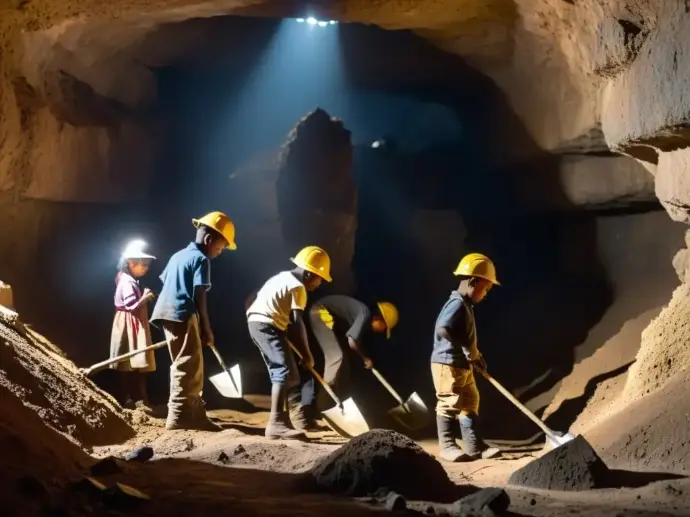
Child Labor Exploitation in Mines: A Hidden Reality
Child labor exploitation in mines is a complex issue influenced by several interrelated factors. First, extreme poverty is one of the main drivers that drive families to allow their children to work in dangerous conditions. The lack of economic opportunities and the need for additional income leads many families to turn to child labor as a way to survive. Furthermore, the lack of government regulation and oversight in some mining regions allows child labor exploitation to persist unchecked. The absence of effective laws to protect children and corruption in local authorities contribute to the perpetuation of this problem. The role of mining companies is also crucial in this problem. The pressure to reduce costs and maximize profits often leads to the hiring of child laborers, as they are cheaper and less likely to organize in unions or demand fair working conditions.
Children working in mines face extremely dangerous conditions and significant risks to their health and safety. Mines are often hostile environments, with the presence of toxic substances, dust, intense noise, and the constant threat of cave-ins or accidents.
In addition, these children frequently perform heavy, repetitive labor that can lead to musculoskeletal injuries and developmental problems. Exposure to toxic chemicals can cause serious illnesses, and the lack of adequate protective equipment further exacerbates these risks.
The combination of long workdays, exposure to unhealthy conditions, and lack of access to adequate medical care places these children in a position of extreme vulnerability, with short- and long-term consequences for their physical and psychological well-being.
Children's involvement in exploitative labor in mines has devastating repercussions on their education and development. By engaging in grueling and dangerous work, they are deprived of the opportunity to receive a formal education and develop skills that would allow them to escape the cycle of poverty they find themselves in.
Furthermore, exposure to such harsh working environments at a young age can have lasting effects on their physical and mental health. The lack of educational and personal development opportunities perpetuates the intergenerational transmission of poverty, contributing to the persistence of child labor exploitation in mining.
Child labor exploitation in mining not only represents a flagrant violation of children's human rights but also has a devastating impact on their well-being and on the development of the communities where this practice is perpetuated.
Child labor exploitation in the mining sector is a global concern that has led to the creation of specific laws and regulations to protect children from this form of abuse. At the international level, the International Labor Organization (ILO) has established Convention 182, which prohibits the worst forms of child labor, including exploitation in mines and quarries. This Convention is a crucial reference point for countries seeking to eradicate child labor exploitation in the mining sector.
At the national level, many countries have enacted specific laws and regulations to address child labor exploitation in mines. For example, in countries such as Bolivia, India, and the Democratic Republic of the Congo, laws have been implemented prohibiting the employment of minors in mines and establishing penalties for those who violate these regulations. These laws seek to protect children's rights and ensure they receive education and safe conditions instead of being exploited in dangerous and detrimental environments. Furthermore, collaboration between governments, international organizations, civil society, and the mining industry is crucial to ensure compliance with these laws and regulations. Transparency, monitoring, and effective enforcement of regulations are essential to protect children from labor exploitation in the mining sector and to promote responsible practices in the industry.
Challenges and Conflicts in the Mining Industry Related to Child Labor Exploitation
Child labor exploitation in mines is a phenomenon that highlights the conflict between economic interests and human rights. In many cases, low-income families are forced to send their children to work in mines to survive, while mining companies seek to maximize profits by reducing labor costs. This reality poses an ethical and moral dilemma, as child labor in dangerous and grueling conditions violates children's fundamental rights.
The pressure to obtain minerals at low cost and in large quantities has led to an imbalance in the protection of children's rights, generating a debate about the need to establish stricter regulations and more effective oversight mechanisms to ensure that mining activities do not occur at the expense of children.
It is crucial to address this issue from a comprehensive perspective that recognizes the importance of reconciling economic development with unrestricted respect for human rights, particularly those of children who, in their vulnerable condition, require special protection.
The presence of child labor exploitation in mines not only represents a violation of human rights but also generates social and community conflicts. The inclusion of children in mining work can trigger tensions in communities, as families are faced with the need for income and the protection of their children.
These conflicts manifest themselves in internal disputes, divisions within communities, and a deterioration of the social fabric, which in turn makes it difficult to find effective solutions. Furthermore, child labor exploitation contributes to the perpetuation of the cycle of poverty, limiting the development opportunities of future generations and weakening the social fabric of affected communities.
It is essential to address child labor exploitation in mines from a perspective that considers not only the individual dimension of the affected children but also the impacts on their families and communities. Resolving these conflicts requires comprehensive approaches that promote respect for human rights and the generation of sustainable economic opportunities for mining communities.
Mining companies play a critical role in eradicating child labor exploitation in mines. Through the implementation of responsible policies and practices, companies can actively contribute to protecting children's rights and promoting safe and ethical work environments.
Adopting international standards, training staff on human rights, and monitoring the supply chain are some of the strategies companies can employ to prevent and eliminate child labor in their mining operations. Collaboration with local and government organizations is also essential to address the underlying causes of child labor exploitation and promote the development of sustainable alternatives for families.
Proactive corporate participation in eradicating child labor exploitation not only helps protect children but also strengthens their reputation, fosters the sustainability of their operations, and promotes an environment that respects human rights. This collaboration between the private sector, communities, and other relevant stakeholders is essential to effectively address this challenge and move toward a future in which mining is compatible with full respect for children's rights.
In response to the problem of child labor exploitation in mines, various organizations and governments have implemented intervention initiatives and programs to address this serious problem. These initiatives seek to protect children's rights and ensure their well-being, as well as offer alternatives to labor exploitation.
Some of the measures adopted include the creation of educational programs that seek to keep children out of mines and in classrooms. These programs provide educational opportunities and support to families to ensure that children have access to education and are not forced to work in dangerous conditions.
In addition, psychological and social support programs have been established for children rescued from mines to help them reintegrate into society and overcome the physical and emotional consequences of labor exploitation. These initiatives seek to provide a safe and protective environment for children and promote the fulfillment of human rights in mining communities.
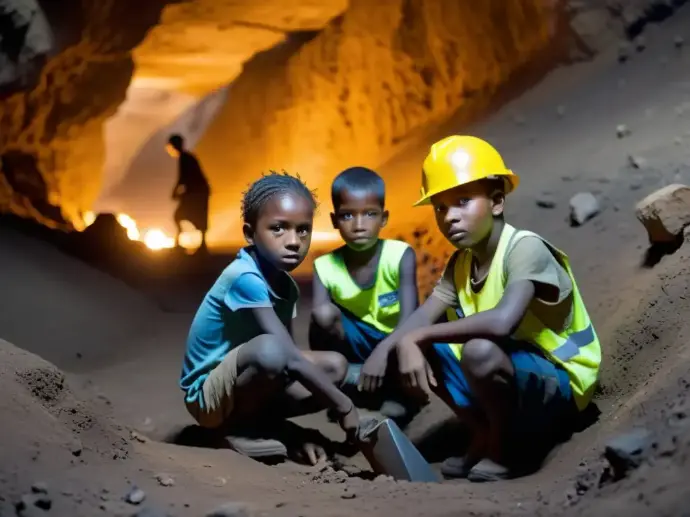
Impact on Global Human Rights
Child labor exploitation in mines has a direct connection with children's fundamental rights. Working in dangerous and unhealthy conditions constitutes a clear violation of children's rights to education, health, and play. Furthermore, this practice negatively impacts their physical, mental, and emotional development, depriving them of a safe and healthy childhood.
Child labor exploitation in mines not only violates children's rights but also perpetuates a cycle of poverty and inequality, depriving children of the opportunity to access education and a better future. It is crucial to address this issue from a comprehensive perspective that addresses both working conditions and the underlying causes that perpetuate it. Human rights defenders play a fundamental role in denouncing and preventing child labor exploitation in mines, advocating for policies and measures that protect children's rights and promote their well-being. Their work is essential to raising awareness of this problem internationally and pressuring governments and companies to take concrete steps to eradicate it.
Child labor exploitation in mines is a matter of international concern, as it affects a large number of children in different countries around the world. According to the International Labor Organization (ILO), it is estimated that around 1 million children work in mines in dangerous conditions that are detrimental to their health and development.
This issue has received attention from international organizations such as the UN, which has urged countries to take concrete measures to eradicate child labor exploitation in all its forms, including mining. International conventions and protocols have also been established to protect children's rights and guarantee their well-being, promoting the ratification and compliance of these agreements by States.
Child labor exploitation in mines not only affects children individually but also has economic and social repercussions, perpetuating poverty and inequality in the communities where it occurs. A comprehensive and collaborative approach is needed to address this issue, involving governments, businesses, international organizations, and civil society.
Human rights defenders play a crucial role in the fight against child labor exploitation in mines. Their work involves raising awareness of this issue, denouncing abuses and violations of children's rights, and advocating for concrete policies and actions that protect their well-being.
Furthermore, human rights defenders work closely with affected communities, providing support, advice, and empowerment so they can demand their rights and participate in decision-making that affects their lives. Their work is essential to raising awareness, mobilizing public opinion, and pressuring governments and businesses to assume their responsibility in eradicating child labor exploitation in mines.
The work of human rights defenders is based on a commitment to justice, equity, and respect for human dignity. Their courage and determination are a beacon of hope for children suffering the consequences of labor exploitation in mines, and their work is essential to building a world where the rights of all children are respected and protected.
Actions and Solutions
Child labor exploitation in mines is a complex problem that requires concrete actions and solutions to protect children in this situation. Empowering local communities, implementing supportive policies and programs, and corporate social responsibility are key to effectively addressing this issue.
The empowerment of local communities is crucial to combating child labor exploitation in mines. Communities must be trained and strengthened so they can identify and report situations of child labor, as well as seek sustainable alternatives that enable economic development without resorting to child labor.
It is important to provide educational and training tools to members of these communities so they can understand their rights, demand fair working conditions, and access opportunities that do not depend on child labor.
Furthermore, psychological and emotional support for families and children affected by labor exploitation is essential to breaking the cycle of poverty and child labor in these communities.
The implementation of support policies and programs by governments and international organizations is essential to eradicating child labor exploitation in mines. These policies must include the protection of children's rights, access to education, healthcare, and ensuring safe working conditions for adults, so that they are not forced to resort to child labor as their only option.
Likewise, it is necessary to establish school and social reintegration programs for children who have been victims of labor exploitation, providing them with both academic and emotional support so they can recover their childhood and have the opportunity for a more promising future.
These programs must be designed and implemented comprehensively, involving various stakeholders, from governments to non-governmental organizations and businesses, to ensure a significant and sustainable impact over time.
Companies operating in the mining industry have a responsibility to ensure that child labor is not present in their operations and throughout their supply chain. Corporate social responsibility entails respecting human rights, complying with labor regulations, and promoting fair and safe working conditions.
Mining companies must implement rigorous monitoring and enforcement mechanisms to prevent and eliminate all forms of child labor, as well as to ensure that their activities do not contribute to the exploitation of children in mining operations.
Furthermore, it is critical that these companies contribute to the development of the communities in which they operate by promoting education, health, and economic development initiatives that benefit families and children, providing viable alternatives to child labor.
Combating child labor exploitation in mining operations requires strong international collaboration and effective inter-agency cooperation. Given the transnational nature of many mining companies, it is essential that governments, international organizations, NGOs, and the companies themselves work together to address this issue. International collaboration can help establish global standards for the protection of children's rights in the mining context and ensure that companies operating in different countries comply with these standards.
Likewise, inter-agency cooperation at the local and national levels is essential to identify and rescue children working in dangerous conditions in mines. This involves coordination between ministries of labor, child protection agencies, law enforcement agencies, and other relevant entities to ensure that labor laws are enforced and assistance is provided to affected children. Furthermore, cooperation between mining companies and local communities is crucial to implementing sustainable development programs that offer economic alternatives to families and help prevent child labor exploitation.
International collaboration and inter-agency cooperation are not only critical to addressing child labor exploitation in mines, but are also essential to promoting a comprehensive approach that encompasses education, healthcare, social protection, and community empowerment to protect children's rights and ensure a dignified future.
Conclusions
The eradication of child labor exploitation in mines has a significant long-term impact in several areas. First, it allows children access to education and opportunities for personal and professional development. By not being exposed to hazardous working conditions, their health and overall well-being improve, contributing to the development of a healthier and more skilled generation. Furthermore, eliminating child labor encourages the hiring of qualified adults, which can improve productivity and quality in the mining industry.
The role of awareness-raising and collective action is fundamental in the fight against child labor exploitation in mines. Raising awareness at both the local and international levels is crucial to generating meaningful change. Governmental and non-governmental organizations, and society as a whole, must join forces to implement policies, programs, and measures that guarantee the protection of the rights of children living in mining communities. Likewise, it is essential to promote corporate social responsibility so that mining companies commit to respecting human rights and ensuring safe and fair working conditions for all.
Future challenges in eradicating child labor exploitation in mines require a continued focus on promoting and protecting human rights in the mining industry. Effective implementation of policies and regulations, adequate monitoring of working conditions, and fostering transparency in the supply chain are key aspects that must be addressed. It is crucial to continue promoting the active participation of all stakeholders, including governments, companies, civil society organizations, and communities, to ensure that children's rights are not violated in any mining context.
Final Reflection: The Lasting Impact of Child Labor in Mines
Child labor in mines is a hidden reality that continues to affect children today, despite efforts to eradicate it. This issue continues to influence the social and cultural landscape, reminding us that the fight for children's rights is a shared responsibility. As Nelson Mandela said, "The true mark of a just society is equal opportunity for children."
It is crucial to reflect on the impact of child labor in mines and take concrete steps to protect children from this injustice. Each of us can contribute to creating a world where children can grow and develop in a safe and dignified environment.
